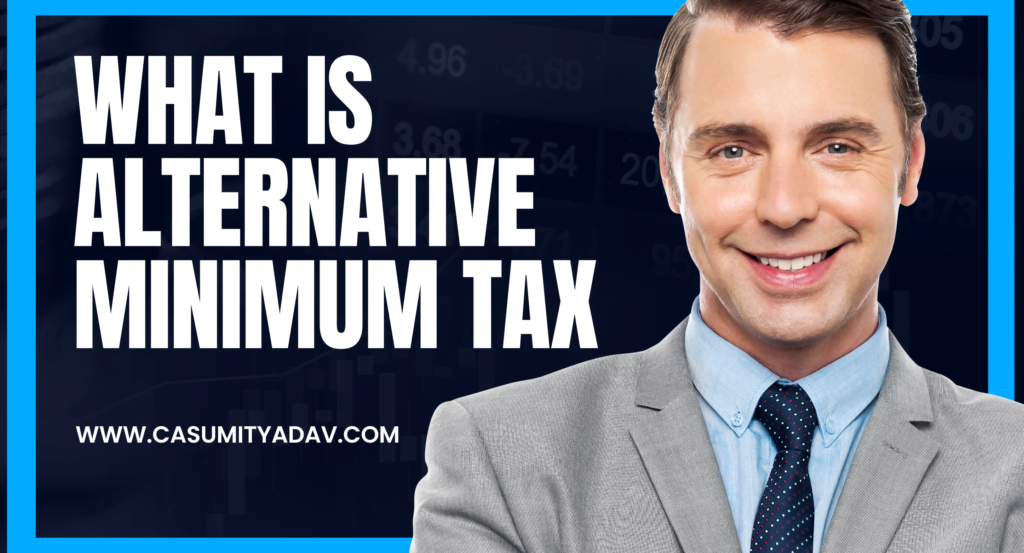What is Alternative Minimum Tax?

Table of Contents

AMT – What is Alternative Minimum Tax ?
The Government has put in place several measures to incentivize investment in various industries, which include profit-linked deductions as well as other incentives. This measure has had the effect of reducing taxes for eligible taxpayers, which in some cases has resulted in some companies paying little or no taxes. While this is good for these companies, the Government still requires taxes to be paid in order to fund various programs, expenses and initiatives that benefit the country’s citizens. To that end, the concept of Minimum Tax was introduced, which ensures that qualifying zero or marginal tax-paying companies pay a certain level of tax as a contribution to the public purse. Minimum Alternate Tax (MAT) is the tax paid by companies when their normal tax payable is lower than MAT. To calculate MAT, adjustments are made to the total income of the companies. The credit for MAT paid in earlier years can be carried forward and set off in subsequent years when normal tax payable is higher than MAT. Similarly, Alternative Minimum Tax (AMT) is a tax on non-corporate taxpayers and operates on similar principles to MAT, but with some differences in terms of applicability, adjusted income calculation, exemptions, and reporting requirements.
Alternative Minimum Tax – Basics
AMT is a type of tax that is an alternative to the normal tax. With AMT, you pay either 18.5% or 9% (if you are located in an International Financial Services Centre and receive income only in convertible foreign currency) of your adjusted total income. Starting from the 2023-24 assessment year, the rate for co-operative societies is reduced to 15%.
AMT is a tax that you pay if your normal tax is lower than the AMT you have to pay based on your adjusted total income. Even if you pay normal tax, you still have to pay AMT if it applies to you.
Applicability of AMT
The “minimum alternate tax” (AMT) is a rule that says if you claim certain tax deductions, you need to pay a minimum amount of tax, regardless of how much you earn. This rule was first for companies, but now also applies to people like individuals, families, and groups, who earn more than Rs. 20,00,000. However, you only have to pay this extra tax if you claimed certain deductions. For example, some deductions for businesses or special projects might mean you have to pay AMT. If you earn money from a business, you might be subject to AMT, but only if you would otherwise pay less tax. Some people are excluded from AMT, including those who pay taxes at a lower rate and some groups with certain types of income.
Exemption from Applicability of AMT
It is important to understand the applicability of the AMT provisions to taxpayers. This provision does not apply to
individual taxpayers, HUF, AOP, BOI, and artificial juridical persons
whose annual income is less than Rs. 20,00,000.
This monetary threshold is significant because those who meet this condition are exempt from paying the AMT.
However, it is important to note that the exemption does not extend to LLPs, partnership firms, and other non-corporate assesses. This means that companies falling in this category will be required to pay the AMT, regardless of their annual income. As helpful assistants, it is important for us to provide clear and comprehensive information to aid in decision-making regarding financial matters.
AMT Credit
The Alternative Minimum Tax, or AMT, was created to ensure a consistent flow of revenue to the public fund, even from companies with zero tax liability. If a company pays minimum tax in a fiscal year where their normal tax rate is lower than their AMT, they can carry forward that excess AMT and use it to offset the difference in future fiscal years. This concept is known as AMT Credit. However, this credit can only be carried forward for up to 15 fiscal years following the initial payment of AMT. In the event of any changes to normal tax due to an Income Tax Department order, the AMT credit will also adjust accordingly. Additionally, any foreign tax credit claimed against AMT cannot exceed the amount of AMT paid.
Calculation of Adjusted Total Income
Adjusted total income and AMT is arrived in the following manner:
| Particulars | Amount (in Rs) |
| Taxable income (A) | XXXXX |
| Add: Deduction claimed if any under Chapter VI-A from 80H to 80RRB except 80P (B) | XXXXX |
| Deduction claimed if any under Section 10AA (C) | XXXXX |
| Deduction claimed if any under Section 35AD reduced by regular depreciation allowed (D) | XXXXX |
| Adjusted total income (E) = (A)+(B)+(C)+(D) | XXXXX |
| AMT – 18.5% of (E) | XXXXX |
Computation of Tax Liability When AMT Provisions are Applicable
| Particulars | Amount (in Rs) |
| Tax liability computed as per normal provisions of the Income-tax Act – normal tax liability | XXXX |
| AMT computed at 18.5% (plus applicable surcharge and cess) on adjusted total income | XXXX |
| Tax liability of taxpayer | Higher of the above |
Claiming of AMT Credit
The following conditions must be satisfied to claim AMT credit:
- The credit should set off up to the maximum period of the 15 assessment years.
- No interest is allowed to be payable on such credit.
- The tax credit under Section 115JD varies in case the amount of normal income tax or any AMT changes due to any order passed under the Income Tax Act.
The assessee can also set off bought forward AMT credit during the financial year in which the total adjusted income does not exceed Rs. 20 lakhs after claiming deduction under Section 10AA, Section 35AD or Chapter VI-A.
Reporting Requirement
All taxpayers to whom AMT provisions are applicable is required to obtain a report from Chartered Accountant certifying that adjusted total income and AMT have been computed as per provisions of Income-tax Act, in Form No. 29C and furnish the report on or before the due date for filing the return of income. Report can be filed electronically along with return of income.
Screenshot of Form No. 29C is given below:

Illustration
Illustration (assuming status of taxpayer to be individual)Amount (in Rs)
| Particulars | FY 1 | FY 2 |
| Taxable income (A) | 19,30,000 | 20,50,000 |
| Add: Deduction claimed if any under Chapter VI-A from 80H to 80RRB except 80P (B) | 1,00,000 | Nil |
| Deduction claimed if any under Section 10AA (C) | 75,000 | 25,000 |
| Deduction claimed if any under Section 35AD reduced by regular depreciation allowed (D) | 4,50,000 | Nil |
| Adjusted total income (E) = (A)+(B)+(C)+(D) | 25,55,000 | 20,75,000 |
| Comparison of normal tax and AMT | ||
| AMT – (18.5% of (E) plus education cess @ 3%) (F) | 4,91,582 | 3,99,230 |
| Tax liability computed as per normal provisions of the Income-tax Act – normal tax liability as per applicable slab for individual including education cess (G) | 4,07,160 | 4,44,600 |
| Tax liability of taxpayer – (H) = Higher of (F) and (G) | 4,91,582 (AMT being the tax liability, AMT can be c/f to next FY for set off if any) | 4,44,60 |
| Less: MAT Credit b/f (restricted to excess of normal tax over AMT) As only Rs 45,370 (Rs 4,44,600-3,99,230) is claimed in FY 2 out of total AMT credit of Rs 84,422 balance unclaimed AMT credit of Rs 39,052 can be carried forward for set off till next 15 financial years | Nil | 45,370 |
| Final tax liability of taxpayer (rounded off) | 4,91,582 | 3,99,230 |













